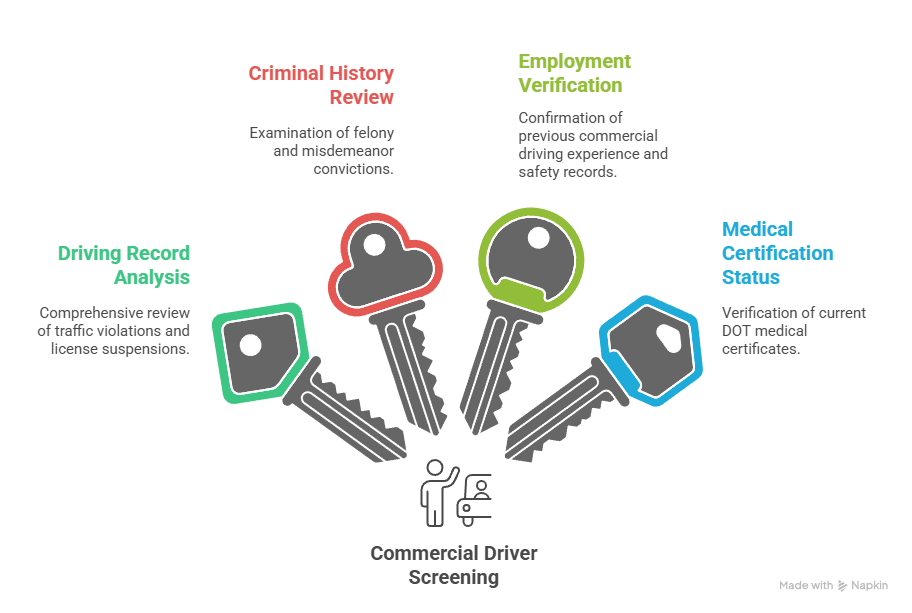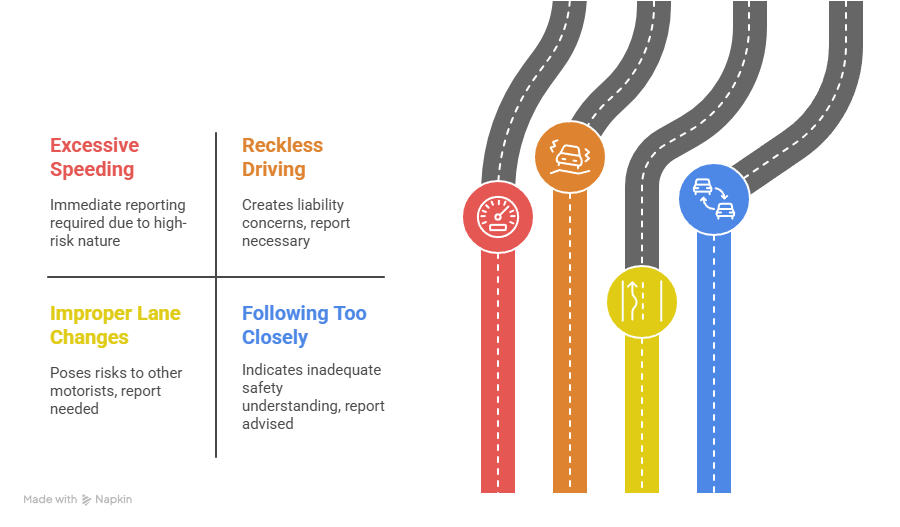Texas commercial driver background checks involve comprehensive multi-state screenings mandated by both federal FMCSA regulations and Texas DPS requirements. These screenings examine driving records, criminal history, employment verification, and medical certifications. Understanding these requirements is essential for both employers seeking compliant hiring practices and drivers navigating the CDL application process.
Key Takeaways
- Comprehensive screening required: Texas CDL background checks examine driving records from all states where drivers held licenses in the past three years. Additionally, they review criminal history, employment verification, and current DOT medical certifications.
- Federal and state compliance mandatory: Both FMCSA regulations and Texas DPS requirements must be met. Specifically, this includes disqualifications for DWI convictions, felony vehicle use, and serious traffic violations.
- Timeline varies by complexity: Standard background checks take 1-2 weeks. However, delays can occur due to incomplete documentation, multi-state record verification, or criminal history investigations.
- Employer responsibilities extensive: Companies must conduct pre-employment screenings and maintain ongoing monitoring programs. Furthermore, they must ensure FCRA compliance and document all verification processes.
- Driver rights protected: FCRA provisions guarantee written consent requirements and dispute resolution processes. Moreover, they ensure accuracy standards for all background check information.
- Industry-specific variations exist: HazMat endorsements require additional TSA security screenings. Meanwhile, passenger transport services demand specialized certifications and enhanced safety protocols.
What Are Texas Commercial Driver Background Checks?
Texas commercial driver background checks represent comprehensive evaluations mandated by federal Department of Transportation regulations. Additionally, Texas Department of Public Safety requirements govern these screenings. These evaluations ensure only qualified, safety-conscious individuals operate commercial motor vehicles (CMVs) on public roadways.
The process involves systematic review of multiple databases and employment records. Furthermore, it examines safety performance histories to establish driver eligibility. Consequently, this multi-step approach ensures ongoing compliance with safety standards.
The scope extends beyond basic criminal history checks. Instead, it encompasses driving performance across all jurisdictions where applicants held licenses. Federal regulations require employers to obtain motor vehicle records for every state where drivers were licensed during the preceding three years. As a result, this creates a comprehensive safety profile that addresses the interstate nature of commercial transportation.
Key Components Examined
Modern commercial driver screenings evaluate four critical areas. These areas directly impact public safety and regulatory compliance:

- Driving Record Analysis: This involves comprehensive review of traffic violations and license suspensions. Additionally, it examines commercial vehicle infractions across all states where drivers held licenses in the past three years. Notably, particular attention is given to serious violations like excessive speeding or reckless driving.
- Criminal History Review: This includes systematic examination of felony and misdemeanor convictions. Specifically, automatic disqualifications apply for drug trafficking, violent crimes, or vehicle-related felonies. These crimes demonstrate unfitness for commercial driving responsibilities.
- Employment Verification: This process provides detailed confirmation of previous commercial driving experience. Moreover, it includes safety performance records, accident history, and drug/alcohol testing results. These records come from DOT-regulated employers over the past three years.
- Medical Certification Status: This involves verification of current DOT medical certificates. These certificates ensure drivers meet physical and mental health standards necessary for safe commercial vehicle operation. Specifically, this includes vision, hearing, and cardiovascular requirements.
Each component serves specific regulatory purposes. Additionally, it contributes to overall safety assessment. Employers must document all verification steps to demonstrate compliance during DOT audits. Furthermore, they must maintain detailed records for required retention periods.
Texas DPS Requirements for Commercial Drivers
Initial CDL Application Process
The Texas Department of Public Safety mandates specific documentation requirements for commercial driver licensing. These requirements exceed standard driver's license applications. Applicants must provide valid Texas driver's licenses and certified proof of residency. Additionally, they need completed DL-14A application forms and appropriate fees based on license class and endorsements.
The background verification process begins immediately upon application submission. Consequently, this triggers comprehensive database searches across multiple jurisdictions. Criminal history reviews examine both conviction records and deferred adjudications. This is because Texas DPS considers all criminal justice contacts when evaluating CDL eligibility.
Interstate driving record analysis covers all states where applicants held licenses. Therefore, this ensures comprehensive safety evaluation regardless of previous residency. Medical certification verification confirms current DOT physical examination certificates. However, expired or invalid certifications automatically disqualify applicants until proper documentation is provided.
Ongoing Monitoring Requirements
Texas CDL holders face continuous monitoring obligations throughout their commercial driving careers. Annual medical certificate renewals ensure ongoing physical fitness for commercial vehicle operation. Specifically, requirements vary by driver age and health conditions.
Self-reporting requirements mandate disclosure of all traffic violations within 30 days of occurrence. Additionally, this includes criminal convictions and license actions, regardless of vehicle type involved. Failure to meet ongoing requirements results in immediate CDL sanctions. These sanctions include suspension or revocation depending on violation severity.
Employers share monitoring responsibilities through required annual motor vehicle record reviews. Furthermore, they conduct random drug testing programs. This collaborative approach between drivers, employers, and regulatory agencies maintains safety standards. Moreover, it enables swift response to emerging risk factors.
Federal CDL Regulations Impact
FMCSA Safety Regulations
The Federal Motor Carrier Safety Administration establishes nationwide standards that supersede state regulations. Consequently, this creates uniform safety requirements across all jurisdictions. Mandatory drug and alcohol testing programs apply to all CDL holders regardless of employment status. When positive results occur, they trigger immediate disqualification and return-to-duty protocols.
Hours of Service regulations limit driving time to prevent fatigue-related accidents. Additionally, Electronic Logging Device requirements ensure accurate compliance documentation. Safety performance monitoring through the Safety Measurement System tracks individual driver records. When intervention thresholds are reached, they trigger additional scrutiny or disqualification actions.
These federal mandates create consistent expectations. Meanwhile, they enable state-specific enhancements that address local transportation challenges.
Interstate Commerce Considerations
Commercial operations crossing state boundaries face additional federal oversight requirements. These requirements impact background check processes significantly. Motor carrier operating authorities require comprehensive safety evaluations. These evaluations include detailed driver qualification files and ongoing monitoring programs.
International transportation adds customs and border protection screenings. Furthermore, TWIC cards are necessary for hazardous materials transport in certain jurisdictions. Multi-state operations must maintain compliance with varying state requirements. At the same time, they must meet federal minimum standards.
This complexity requires sophisticated tracking systems and regular legal updates. Therefore, this ensures continued compliance across all operational jurisdictions.
Background Check Process Timeline
Step-by-Step Procedure
Week 1: Application Initiation Initial documentation submission begins the formal background check process. This requires complete application packages including driver's licenses, proof of residency, and medical certificates. Additionally, employment authorization is necessary. Electronic verification systems immediately query multiple databases. Consequently, preliminary results are available within 48-72 hours for most applicants.
Week 2: Comprehensive Verification Detailed verification procedures examine employment histories, criminal records, and multi-state driving records. These procedures use manual review processes. Previous employer contacts confirm safety performance and accident involvement. Moreover, they verify drug testing compliance over the required three-year period.
Common Delays and Solutions
Documentation deficiencies represent the primary cause of processing delays. Incomplete medical certificates, missing employment records, or incorrect personal information extend timelines significantly. Proactive applicants maintain organized documentation files. Additionally, they verify accuracy before submission, reducing processing delays and associated costs.
Multi-state record coordination can create extended timelines. This occurs when previous license jurisdictions experience system outages or processing backlogs. Early application submission, particularly for time-sensitive employment opportunities, helps mitigate these unavoidable delays. Furthermore, it maintains compliance with all regulatory requirements.
Types of Background Checks for Commercial Drivers
Pre-Employment Screening
Federal regulations mandate comprehensive pre-employment investigations. These investigations examine three years of employment history and motor vehicle records from all licensing jurisdictions. Additionally, they review drug/alcohol testing databases. Employers must contact previous DOT-regulated employers directly. They verify safety performance, accident involvement, and testing compliance through standardized inquiry forms.
Criminal history screening extends beyond basic conviction records. It includes pending charges, deferred adjudications, and non-conviction dispositions that might impact driving eligibility. Professional reference verification confirms technical competency and safety consciousness. Furthermore, it evaluates reliability factors that influence overall hiring decisions.
Annual Monitoring Requirements
| Monitoring Element | Frequency | Compliance Requirement |
| Motor Vehicle Records | Annual | All licensing states |
| Medical Certification | Based on certificate | Current and valid |
| Random Drug Testing | DOT-specified rates | Employer-administered |
Continuous monitoring programs ensure ongoing compliance with safety requirements. Additionally, they identify emerging risk factors before they impact public safety. Automated systems flag license actions, conviction records, and medical certification lapses. Consequently, this enables immediate corrective action.
Disqualifying Factors and Violations
Major Disqualifications
Texas Department of Public Safety maintains specific disqualification standards. These standards permanently or temporarily bar commercial driving privileges. Lifetime disqualifications apply to drivers convicted of using commercial vehicles for drug trafficking. Additionally, they apply to multiple DWI offenses or leaving accident scenes involving death or injury. These severe penalties reflect the serious safety risks associated with impaired or irresponsible commercial vehicle operation.
First-time DWI convictions result in one-year CDL disqualifications. Enhanced penalties apply for drivers transporting hazardous materials or passengers. Serious traffic violations accumulate through point systems. Multiple offenses within three years trigger progressive sanctions including license suspension or revocation.
Serious Traffic Violations
The accumulation of serious traffic violations creates escalating consequences. These consequences can permanently impact commercial driving careers:

- Excessive speeding: Violations 15+ mph over posted limits in commercial vehicles trigger immediate reporting requirements. Furthermore, they may result in potential employer sanctions.
- Reckless driving: Willful disregard for safety creates liability concerns. Additionally, it demonstrates poor judgment incompatible with commercial driving responsibilities.
- Improper lane changes: Unsafe driving behaviors in large vehicles pose significant risks to other motorists. Moreover, they indicate inadequate vehicle control skills.
- Following too closely: Tailgating violations suggest inadequate understanding of stopping distances. They also indicate poor knowledge of safe following procedures for commercial vehicles.
Multiple violations within three-year periods result in progressive disqualifications. Second and third offenses carry increasingly severe penalties that can effectively end commercial driving careers.
Employer Responsibilities and Compliance
Hiring commercial drivers creates extensive legal obligations. These obligations extend far beyond basic employment verification procedures. Employers must maintain comprehensive driver qualification files containing all required documentation. Additionally, these files must include verification records and ongoing monitoring results. These files serve as primary evidence of compliance during DOT audits and legal proceedings involving driver performance.
FCRA compliance requires written authorization before conducting background checks. This includes specific disclosure requirements and dispute resolution procedures protecting applicant rights. Pre-adverse action notices provide opportunities for applicants to address questionable information before final hiring decisions. Meanwhile, final adverse action notices document decision-making processes for legal protection.
Safety Performance Monitoring
Ongoing safety oversight programs track driver performance through multiple metrics. These metrics include accident rates, violation frequencies, and customer feedback scores. Progressive discipline procedures address performance deficiencies. At the same time, they provide opportunities for improvement through additional training or performance counseling. These systematic approaches demonstrate employer commitment to safety while protecting against negligent supervision claims.
Regular safety meetings, performance evaluations, and recognition programs reinforce safety priorities. Furthermore, they build positive workplace cultures. Investment in driver development through continuing education and safety incentives often produces measurable improvements. Specifically, this improves overall safety performance and regulatory compliance.
Rights and Protections for Drivers
FCRA Compliance Requirements
The Fair Credit Reporting Act provides comprehensive protections for commercial drivers undergoing background investigations. These protections ensure accuracy, privacy, and fairness throughout the screening process. Employers must obtain written consent before initiating background checks. Additionally, they must provide clear disclosure of information sources and intended uses. These consent requirements prevent unauthorized investigations while enabling informed decision-making by job applicants.
Adverse action procedures require employers to provide copies of background reports before making negative employment decisions. Additionally, they must provide summary of rights notices. This pre-decisional disclosure enables applicants to identify and dispute inaccurate information before final determinations. Consequently, this protects against errors that could unfairly impact employment opportunities.
Dispute Resolution Process
When inaccuracies appear in background reports, drivers possess specific rights to challenge and correct erroneous information. This occurs through established dispute procedures. Consumer reporting agencies must investigate disputed items within 30 days. During this process, they contact original information sources to verify accuracy. Unverifiable information must be deleted from reports. Additionally, corrected versions are provided to applicants and recent report recipients.
Drivers can add explanatory statements to reports when disputes remain unresolved. This ensures their perspectives accompany future report distributions. These procedural protections maintain report accuracy. Moreover, they provide recourse for individuals affected by database errors or identity confusion issues.
Best Practices for Job Seekers
Preparation Strategies
Successful commercial driver applicants maintain organized documentation systems. These systems contain all required certificates, licenses, and employment records in both physical and digital formats. Regular Motor Vehicle Record reviews identify potential issues before they impact employment opportunities. Additionally, proactive correction of database errors prevents application delays. Medical certificate renewals should occur 30-60 days before expiration to ensure continuous compliance without gaps that could impact employment eligibility.
Professional development through additional certifications demonstrates commitment to excellence. This includes safety training programs and industry-recognized credentials. Furthermore, it differentiates candidates in competitive job markets. Networking within transportation industries provides insights into employer expectations. Moreover, it highlights emerging regulatory requirements that could impact career advancement opportunities.
Application Process Optimization
Streamlined application procedures begin with thorough job requirement analysis. This ensures complete understanding of position-specific needs and documentation requirements. Prompt response to employer inquiries and documentation requests demonstrates professionalism. Additionally, it maintains application momentum.
Transparency regarding past violations or employment issues often produces better outcomes than attempting to conceal problems. This transparency should be accompanied by evidence of corrective actions. These problems will inevitably surface during background investigations.
Digital portfolio organization enables rapid response to documentation requests. Furthermore, it presents a professional image to potential employers. Regular updates ensure currency and accuracy of all information. This reduces verification delays and demonstrates attention to detail valued by safety-conscious transportation companies.
Industry-Specific Requirements
Hazardous Materials Transport
Transportation Security Administration screenings for HazMat endorsements involve comprehensive background investigations. These investigations examine criminal history, immigration status, and potential security threats. Fingerprint-based FBI checks examine nationwide criminal databases. Additionally, screening covers terrorism-related activities and associations. These enhanced security measures reflect the elevated risks associated with hazardous materials transportation. Furthermore, they require five-year renewal cycles to maintain current threat assessments.
Security Threat Assessments evaluate multiple risk factors. These factors include criminal history, immigration violations, and mental health records that could indicate potential security risks. Disqualifying factors include terrorism-related convictions and espionage activities. Additionally, certain violent crimes demonstrate unsuitability for hazardous materials access.
Passenger Transport Services
| Service Type | Special Requirements | Additional Screening |
| School Bus | Child safety background | Working with minors checks |
| Public Transit | Passenger interaction training | Customer service evaluation |
| Tour/Charter | Commercial passenger endorsement | Safety record emphasis |
School bus drivers face enhanced scrutiny regarding interactions with minors. This includes comprehensive criminal history checks focusing on crimes against children and substance abuse violations. Additional training requirements cover student management and emergency procedures. Furthermore, they include special needs accommodation that extend beyond standard commercial driving competencies.
Public transit operations require customer service skills and crisis management capabilities. These skills influence hiring decisions beyond basic driving qualifications. These positions often involve conflict resolution and disability accommodation. Additionally, they require emergency response situations that demand specialized training and temperament assessment.
State-Specific Considerations
Texas Unique Requirements
Texas Department of Public Safety implements residency verification procedures that exceed federal minimums. These procedures require multiple forms of address confirmation and utility service documentation. Medical certification standards follow federal guidelines. However, they include state-specific reporting requirements for certain conditions and medications that could impact driving safety. These enhanced requirements reflect Texas's commitment to transportation safety. Additionally, they accommodate the state's diverse geographical and operational challenges.
Oil and gas industry transportation involves specialized permits and environmental compliance requirements unique to Texas energy sector operations. Drivers in these industries must understand both transportation regulations and environmental protection standards. These standards govern hazardous materials handling and spill response procedures.
Multi-State Operations
Commercial carriers operating across multiple states must maintain compliance matrices. These matrices address varying regulatory requirements, fee structures, and documentation standards. Centralized compliance systems track driver qualifications against all operational jurisdictions. Additionally, they provide alerts for upcoming renewals or regulatory changes. This systematic approach prevents inadvertent violations while minimizing administrative burden on drivers and employers.
Interstate operations require coordination with multiple regulatory agencies. Each agency maintains independent databases and communication systems. Effective compliance programs establish relationships with key personnel in relevant agencies. Furthermore, they maintain current contact information and procedural guidance for all operational jurisdictions.
Conclusion
Texas commercial driver background checks represent critical safety measures that protect public welfare. Additionally, they ensure regulatory compliance across the transportation industry. The comprehensive nature of these investigations spans multiple jurisdictions and examines diverse risk factors. Consequently, this creates thorough evaluation processes that identify qualified, safety-conscious drivers. Both employers and drivers benefit from understanding these requirements. This understanding enables proactive preparation and systematic compliance that supports successful commercial driving careers.
Success in navigating Texas CDL background check requirements depends on preparation, transparency, and ongoing commitment to safety excellence. Drivers who maintain organized documentation and address issues promptly position themselves for career advancement opportunities. Additionally, those who demonstrate continuous improvement in safety performance achieve better outcomes. Employers who implement comprehensive screening programs and maintain detailed records create competitive advantages. Furthermore, they fulfill their regulatory and public safety obligations through investment in ongoing driver development.
Frequently Asked Questions
How do you get a commercial driver's license in Texas?
To obtain a CDL in Texas, you must hold a valid Texas driver's license first. Additionally, you need to pass vision and knowledge tests and complete the CDL application process. You must also successfully complete skills testing for your desired license class. Furthermore, you must undergo comprehensive background checks and maintain current DOT medical certification throughout the licensing process.
How far back do employers check driving records in Texas?
Texas employers typically review driving records for the past three years as required by federal regulations. However, some companies may examine longer periods for specific positions. Motor vehicle records from all states where drivers held licenses during this period must be obtained and evaluated.
Does Texas follow the 7-year rule for background checks?
Texas generally follows the 7-year rule for most background check purposes. This limits reporting of non-conviction criminal records to seven years. However, certain positions and serious convictions may be reported indefinitely. This is particularly true for safety-sensitive transportation roles.
What disqualifies you from getting a CDL in Texas?
Major disqualifications include DWI convictions and using vehicles for drug trafficking. Additionally, serious traffic violations, certain medical conditions, and failure to meet residency requirements are disqualifying. Multiple serious violations within three years can also result in progressive disqualification periods.
What is the background check policy in Texas?
Texas background check policies vary by employer. However, they must comply with federal FCRA requirements including written consent and adverse action procedures. Additionally, they must provide dispute resolution rights. Commercial driver checks must examine criminal history, driving records, employment verification, and medical certification status.
How much do CDL drivers make in Texas?
CDL drivers in Texas earn average annual salaries ranging from $45,000 to $85,000. This depends on experience, specialization, route types, and employer. Long-haul drivers, hazardous materials specialists, and owner-operators typically earn higher compensation than local delivery drivers.
Who is eligible for a CDL license in Texas?
CDL eligibility requires minimum age 18 for intrastate operations or 21 for interstate commerce. Additionally, you need a valid Texas driver's license, proof of residency, and a clean driving record. You must also have current DOT medical certification and successful completion of all required testing procedures.
What happens if you get caught driving a commercial vehicle without a CDL in Texas?
Operating commercial vehicles without proper CDL authorization results in significant fines and potential criminal charges. Additionally, it causes disqualification from obtaining CDL for specified periods. There is also possible civil liability for accidents or violations occurring during unauthorized operation.
How long does it take to get a CDL in Texas?
The CDL application process typically requires 4-8 weeks. This depends on training program completion, testing schedules, and background check complexity. Additional time may be needed for specialized endorsements or addressing documentation deficiencies.
What are the different classes of CDL in Texas?
Texas offers Class A CDL for combination vehicles over 26,001 pounds GVWR. Class B covers single vehicles over 26,001 pounds. Additionally, Class C is for vehicles designed to transport 16+ passengers or hazardous materials regardless of weight.
Additional Resources
- Texas Department of Public Safety - Commercial Driver License Information
https://www.dps.texas.gov/section/driver-license/commercial-driver-license-cdl - Federal Motor Carrier Safety Administration - Driver Requirements
https://www.fmcsa.dot.gov/regulations/title49/section/391.23 - Transportation Security Administration - Hazmat Endorsement Requirements
https://www.tsa.gov/for-industry/hazmat-endorsement - Fair Credit Reporting Act Compliance Guide
https://www.ftc.gov/enforcement/rules/rulemaking-regulatory-reform-proceedings/fair-credit-reporting-act - DOT Medical Examiner Registry
https://nationalregistry.fmcsa.dot.gov/NRPublicUI/home.seam
Still have questions?
Get in touch with our team today for a personalized demo and discover how our tailored volume pricing and packages can drive results for your business!
How useful was this page?*
Note: your comments are anonymous. We use them to improve the website. Do not include any personal details.
Visit our FCRA Compliance Tool or leave a message here if you need a response.
From the blog Explore the GCheck Content Hub

How Long Do Background Checks Take for Government Jobs? Timeline Expectations for 2026
6 Jan, 2026 • 20 min read
Driver Qualification File Requirements: Your Complete DOT Compliance Guide
6 Jan, 2026 • 18 min read
Healthcare Background Screening Costs: 2026 Budget Planning Guide for Medical Facilities
30 Dec, 2025 • 23 min readThe information provided in this article is for general informational and educational purposes only and should not be construed as legal advice or a substitute for consultation with qualified legal counsel. While we strive to ensure accuracy, employment screening laws and regulations—including but not limited to the Fair Credit Reporting Act (FCRA), Equal Employment Opportunity Commission (EEOC) guidelines, state and local ban-the-box laws, industry-specific requirements, and other applicable federal, state, and local statutes—are subject to frequent changes, varying interpretations, and jurisdiction-specific applications that may affect their implementation in your organization. Employers and screening decision-makers are solely responsible for ensuring their background check policies, procedures, and practices comply with all applicable laws and regulations relevant to their specific industry, location, and circumstances. We strongly recommend consulting with qualified employment law attorneys and compliance professionals before making hiring, tenant screening, or other decisions based on background check information.

